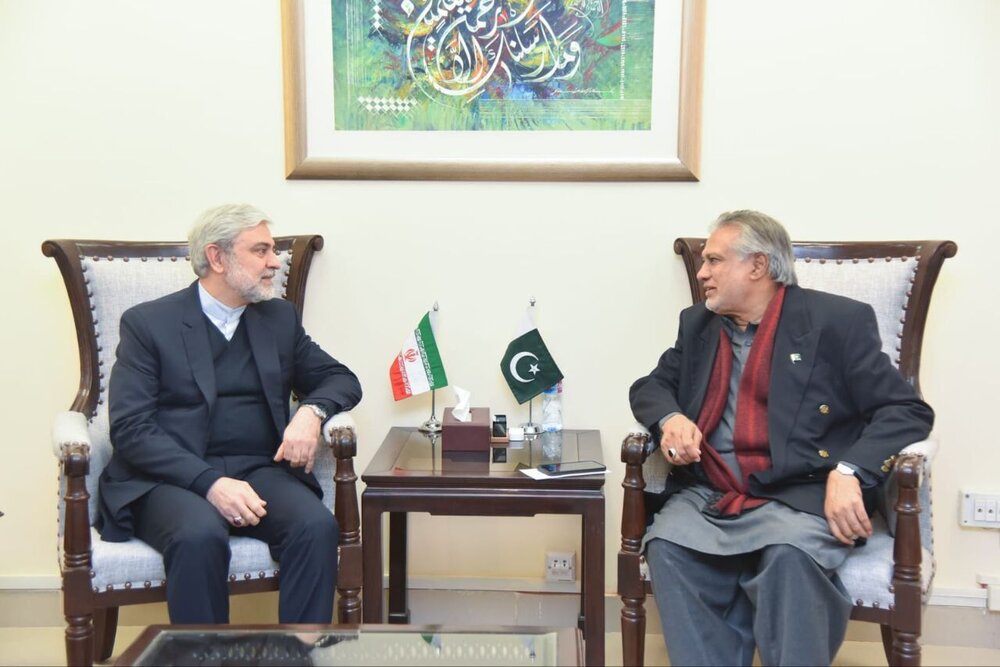Iran, Pakistan explore ways to strengthen bilateral trade

TEHRAN- During a meeting between Pakistan’s Finance Minister Senator Mohammad Ishaq Dar and Iran’s Ambassador to Pakistan Mohammad-Ali Hosseini in Islamabad on Friday, the two sides explored the ways to expand and strengthen trade ties between the two countries.
Emphasizing the high importance of his country's relations with the Islamic Republic of Iran, the Pakistani minister said that Islamabad is ready to remove the obstacles in the way of increasing the volume of bilateral trade with Tehran.
Pakistan always considers its relations with the Islamic Republic of Iran very important. However, the volume of bilateral trade is not favorable and for this purpose Pakistan is ready to take any kind of measures to address the existing obstacles, the official stressed.
Senator Ishaq Dar emphasized that Pakistan is ready to take all possible measures to remove the bottlenecks in order to significantly increase the volume of bilateral trade between the two countries.
Appreciating the economic policies of the government of Pakistan, the Iranian ambassador for his part said, “The historical relations between the two neighbors and the strong cultural and political relations require that our commercial and economic cooperation be at better and stronger levels.”
The two countries have great potential to expand cooperation in the fields of energy, trade and other areas, he emphasized.
After the mentioned meeting, the Ministry of Finance of Pakistan issued a statement and announced: “In this meeting, the opening of border markets, barter trade, free trade agreement and joint investment to increase the volume of trade between Iran and Pakistan were discussed.”
Since the beginning of the current administration in August 2021, the Iranian government has been strongly promoting and pursuing economic diplomacy, especially with the neighboring countries and the countries in the region; and as a longstanding trade partner of the Islamic Republic, Pakistan has been one of the major points of focus for the expansion of trade ties.
Considering the complementary nature of the two countries' economies, common cultural heritage, and positive political relations between the two neighbors, Iran and Pakistan have huge potential for economic cooperation, however, the level of exchanges between the two sides has not been satisfactory over the past few years.
Iran and Pakistan signed a Preferential Trade Agreement (PTA) in August 2006 and the PTA, which came to effect in September that year, was expected to “create a new climate for economic and regional cooperation between the two countries” as stated in the agreement, however, nearly 17 years after the mentioned deal, the two countries annual trade is still under $2 billion dollars.
Lack of proper banking relations and contrary customs regulations are said to be the main obstacles in the way of trade between the two countries.
Despite the above-mentioned issues and obstacles, Iran and Pakistan have set $5 billion of annual trade on the agenda for the next year and to realize the mentioned target, the governments of the two Islamic republics have been taking various measures.
In November 2021, Tehran and Islamabad reached an agreement to use barter trade in order to boost bilateral trade in the face of U.S. sanctions.
In October this year, the Iran Chamber of Commerce, Industries, Mines and Agriculture (ICCIMA) and the Federation of Pakistan Chambers of Commerce and Industries (FPCCI) signed three memorandums of understanding (MOU) with the aim of expanding trade between the private sectors of the two countries.
Also on December 3, Iran’s Trade Promotion Organization (TPO) announced that the imports of all commodities listed under the Iran-Pakistan PTA have been allowed by the government.
Accordingly, Iranian importers have been allowed to register application forms for importing all products that were previously on the IRICA import ban list, from Pakistan.
Along with other measures, this recent step is expected to seriously affect Iran-Pakistan trade and boost the value of trade between the two sides significantly.
According to the Islamic Republic of Iran Customs Administration (IRICA), Iran and Pakistan traded over 2.1 million tons of goods valued at $1.267 billion in the first seven months of the current Iranian calendar year (March 21- October 22). Iran’s exports to Pakistan reached 1.6 million tons worth $704 million in the mentioned seven months, while imports from Pakistan hit 512,000 tons worth $563 million.
Oil and gas products like liquefied petroleum gas, gas liquids, bitumen, liquefied natural gas, and liquefied butane are the main commodities that Iran exports to Pakistan, and agricultural products and foodstuffs comprise the main items of Pakistan’s export basket to Iran.
IRICA’s lifting of the ban on the import of commodities listed under the Iran-Pakistan PTA is going to allow Iranian traders to have a greater choice of commodity items to import from Pakistan and hopefully this measure will be accompanied by removing other barriers in the way of trade.
MA/MA
Photo: Pakistan’s Finance Minister Senator Mohammad Ishaq Dar (R) and Iran’s Ambassador to Pakistan Mohammad -Ali Hosseini
